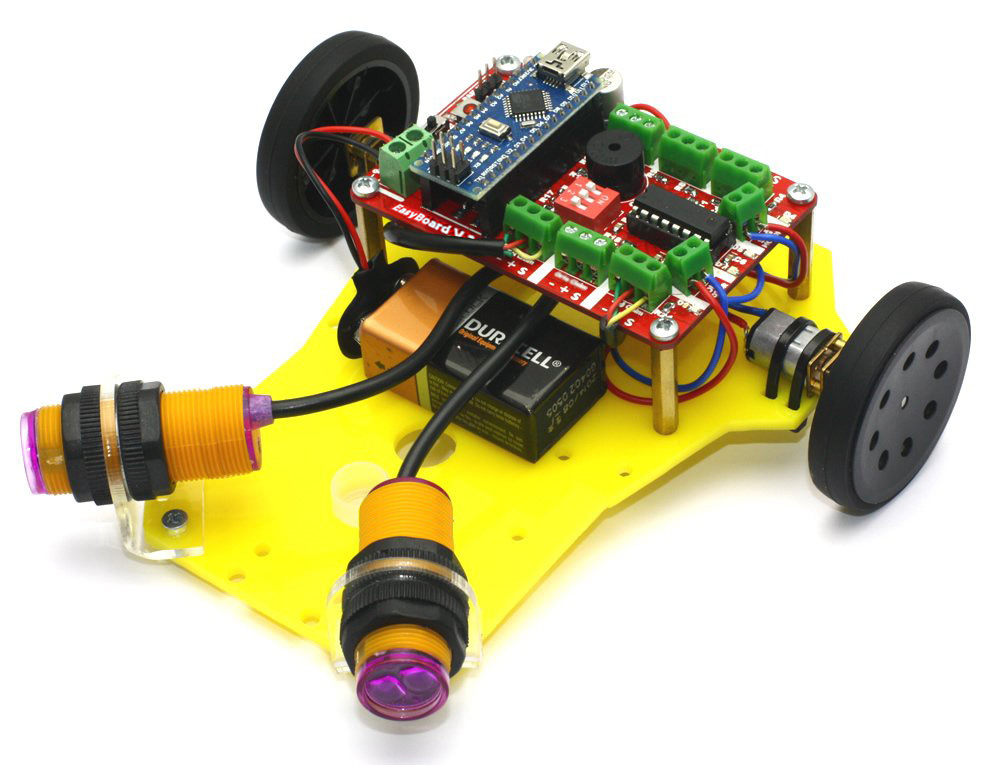Obstacle Avoiding Robot Presentation
| Introduction to Obstacle Avoiding Robot | ||
|---|---|---|
| An obstacle avoiding robot is a type of autonomous robot that can navigate its environment and avoid obstacles without human intervention. These robots use various sensors such as ultrasonic sensors, infrared sensors, or LIDAR to detect obstacles in their path. The main goal of an obstacle avoiding robot is to safely navigate through a given environment while avoiding collisions with obstacles. | ||
| 1 | ||
| How Obstacle Avoiding Robots Work | ||
|---|---|---|
| Obstacle avoiding robots use sensors to detect obstacles in their path. These sensors provide feedback to the robot's control system, which then calculates the robot's next move based on the sensor data. The control system can use various algorithms, such as the Bug Algorithm or Potential Field Algorithm, to determine the best path for the robot to follow and avoid obstacles. | ||
| 2 | ||
| Types of Sensors Used in Obstacle Avoiding Robots | ||
|---|---|---|
| Ultrasonic sensors: These sensors emit high-frequency sound waves and measure the time it takes for the sound waves to bounce back. They are commonly used for short to medium-range obstacle detection. Infrared sensors: These sensors emit infrared light and measure the reflection or absence of the light to detect obstacles. They are effective for short-range obstacle detection. LIDAR (Light Detection and Ranging): LIDAR sensors use laser beams to measure the distance to objects in the robot's surroundings. They provide highly accurate and detailed distance measurements, making them suitable for both short and long-range obstacle detection. |  | |
| 3 | ||
| Advantages of Obstacle Avoiding Robots | ||
|---|---|---|
| Improved safety: Obstacle avoiding robots can navigate hazardous environments without putting human operators at risk, making them ideal for tasks such as mine exploration or search and rescue operations. Increased efficiency: These robots can navigate autonomously, reducing the need for human intervention and increasing productivity in various industries. Versatile applications: Obstacle avoiding robots can be used in a wide range of applications, including household cleaning robots, warehouse automation, and agricultural robotics. |  | |
| 4 | ||
| Challenges Faced by Obstacle Avoiding Robots | ||
|---|---|---|
| Sensor limitations: Different sensors have their limitations, such as limited range or susceptibility to environmental conditions. These limitations can affect the accuracy of obstacle detection. Complex environments: Navigating complex environments with varying obstacles can be challenging for obstacle avoiding robots. They need to be equipped with advanced algorithms and decision-making capabilities to handle such situations effectively. Power management: Obstacle avoiding robots require a constant power supply to operate. Optimizing power consumption and implementing efficient power management systems are crucial to ensure longer operating times. |  | |
| 5 | ||
| Future Developments in Obstacle Avoiding Robots | ||
|---|---|---|
| Artificial Intelligence integration: Future obstacle avoiding robots will likely incorporate AI technologies, such as machine learning and computer vision, to enhance their obstacle detection and decision-making capabilities. Improved sensor technologies: Advancements in sensor technologies, such as longer-range and more accurate sensors, will enable obstacle avoiding robots to operate in more challenging environments. Collaborative navigation: Future robots may be designed to communicate and collaborate with each other, sharing obstacle information and coordinating their movements to navigate complex environments more efficiently. |  | |
| 6 | ||
| Real-world Examples of Obstacle Avoiding Robots | ||
|---|---|---|
| Roomba: The Roomba vacuum cleaner robot is a popular example of an obstacle avoiding robot. It uses a combination of sensors to navigate through rooms and avoid furniture and other obstacles. AGVs (Automated Guided Vehicles): AGVs used in warehouses and factories often employ obstacle avoiding capabilities to navigate through crowded spaces and avoid collisions. Mars rovers: The Mars rovers, such as Curiosity and Perseverance, are equipped with obstacle avoiding capabilities to safely navigate the rocky terrain and avoid hazards on Mars. |  | |
| 7 | ||
| Applications of Obstacle Avoiding Robots | ||
|---|---|---|
| Industrial automation: Obstacle avoiding robots can be used in manufacturing plants to automate material handling tasks, reducing the need for human intervention. Agriculture: These robots can navigate through fields and orchards, performing tasks such as crop monitoring, spraying, and harvesting, without damaging plants or colliding with obstacles. Surveillance and security: Obstacle avoiding robots equipped with cameras and sensors can patrol areas and detect intruders or potential threats, enhancing security measures. |  | |
| 8 | ||
| Conclusion | ||
|---|---|---|
| Obstacle avoiding robots offer a practical and efficient solution for navigating complex environments while avoiding collisions with obstacles. With advancements in sensor technologies and AI integration, these robots will continue to evolve and find more applications in various industries. The future of obstacle avoiding robots holds great potential for improving safety, efficiency, and productivity in a wide range of fields. | ||
| 9 | ||
| Thank You! | ||
|---|---|---|
| Thank you for your attention and for learning about obstacle avoiding robots. If you have any questions or would like to explore more about this topic, feel free to ask. Stay updated with the latest advancements in robotics and automation for more exciting developments in obstacle avoiding robots. | ||
| 10 | ||



